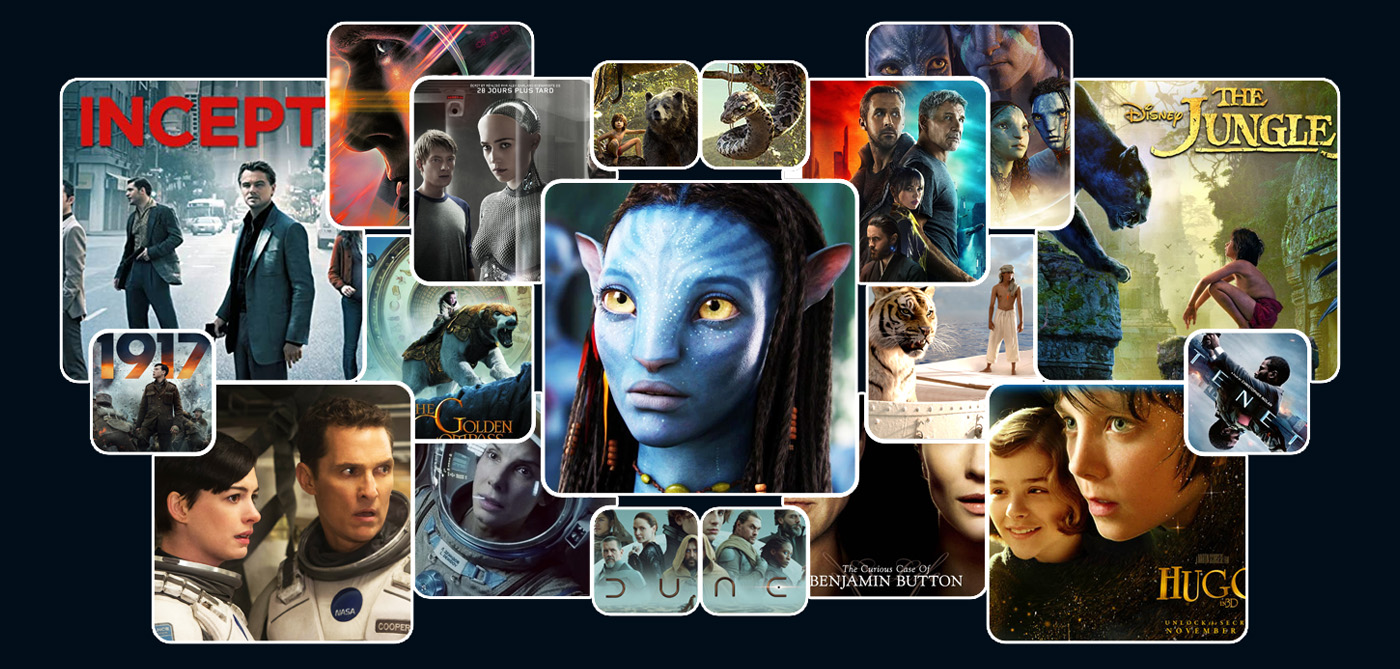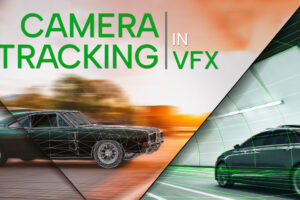
Must Watch Oscar-Winning VFX Movies
Here we are discussing the must-watch Oscar-Winning VFX Movies of all time. These movies left the audience awestruck with their visual effects.
- INCEPTION
- INTERSTELLAR
- THE GOLDEN COMPASS
- GRAVITY
- AVATAR
- LIFE OF PI
- HUGO
- EX MACHINA
- THE JUNGLE BOOK
- THE CURIOUS CASE OF BENJAMIN BUTTON
- BLADE RUNNER 2049
- 1917
- FIRST MAN
- TENET
- DUNE
Visually stunning, this is a phrase that is most commonly used nowadays while reviewing a movie. VFX has the power of changing the entire horoscope of a movie and it’s now an indispensable element in filmmaking. Many VFX institutes and academies include these legendary films in their VFX syllabus. As they function as a live textbook when the respective filmmakers discover new realms of VFX techniques. Like James Cameron who invented new motion capture technology (co-invented with Weta Digital) exclusively for the making of Avatar 2: The Way of Water.
Listed below are the Oscar-winning movies for best VFX in their respective years.
INCEPTION (2010)
Winner of the 2010 Oscars, Inception, Christopher Nolan’s science fiction blockbuster, immersed viewers in a number of captivating dreamscapes. The action-packed movie stretched the limits of physics and visual effects by using breathtaking images that show Parisian architecture turned upside down and a struggle that defies gravity. The renowned Double Negative studio (DNEG) delivered the never-seen-before visual effects. The DNEG team was led by VFX Producer Matt Plummer, VFX Supervisors Pete Bebb and Andy Lockley, as well as Paul Franklin, who had previously overseen the work on the two prior movies.
INTERSTELLAR (2014)
The 3D effects and visual graphics employed in the film Interstellar praised to the hilt. Numerous interstellar planet visualisations shown throughout the film. Additionally, it displays the black hole and wormhole. Which, according to a number of scientists, are the best representations of the two scientific phenomena to date. Most of the VFX institutes include this movie in their VFX course/syllabus as an exemplary definition of efficient VFX implementation.
A dust storm was one of the few visual effects used in Interstellar’s Earth-based scenes. To maintain the film’s realism in contrast to Nolan’s depiction of space travel. Which included a black hole, a wormhole, planets, and the tesseract. A four-dimensional space in which time is perceived as a physical dimension.
THE GOLDEN COMPASS (2008)
Directed by Chris Weitz, The Golden Compass presented a great challenge to the team that assigned by to give the movie one of its heroes: the gigantic armoured polar bear, Iorek Byrnison, voiced by Ian McKellen. The Golden Compass won Framestore its first Oscar in 2008 for Best Visual Effects.
The Golden Compass tells the story of an epic fantasy adventure that takes place in a parallel universe where magic and science coexist. Lyra Belacqua embarks on an epic journey to save not just our planet but also those of other people as she sets out to save her best friend. Pullman’s narrative, which is brimming with intrigue, profundity, and wonder, depicts the unending conflict between good and evil as well as the capacity of one young girl to mend a tear in the cosmos’ fabric.
GRAVITY (2013)
Gravity, the movie that mesmerized the audience to the core received a staggering amount of positive reviews from critics. Garnering enough stars to cover the galaxy it so faithfully depicts. Under the direction of Alfonso Cuarón, London served as the planning and production hub for those top-notch pictures. From pre-production to filming to the lengthy post-production process. It conquered multiple awards including seven Oscars along with Framestore’s three top visual effects honours: the Oscar, BAFTA, and VES Awards.
AVATAR (2009)
The groundbreaking visual effects of Avatar, one of the most costly films ever created with a budget of Rs.1,100 crore. Although the main VFX and special effects delivered by Wētā FX, many VFX studios including the Indian VFX studio Prime Focus which contributed 200+ VFX shots for this film.
The grand debut of James Cameron’s Avatar 2 was released on December. Similar to its prequel, the film’s amazing vistas, CGI work, and, of course, VFX are its main draws. We saw some extraordinary things in the teaser, and the stunning visual indeed satisfied the audience.
LIFE OF PI (2012)
In 2013, Rhythm and Hues studio won the Academy awards for best visual effects. Life of Pi’s visual effects team worked together to bring the most crucial element of an engaging narrative to the screen. In order to make the ocean a significant character and intrigue, the VFX team had to work hard to make it as aesthetically stunning as possible.
HUGO (2011)
The director, Martin Scorsese’s film HUGO received five Academy Awards in 2012 for cinematography, sound editing, sound mixing, visual effects, and art direction. Hugo’s aesthetic style combines 3D animation with live-action. The use of fake sound effects allows the audience to still hear the “natural” sound even while they are using visual effects.
EX MACHINA (2014)
Under the direction of Overall and DNEG VFX Supervisor Andrew Whitehurst, DNEG was responsible for creating the iconic android ‘Ava’.
Ex Machina’s production split among four locations. The android, Ava, constructed by Double Negative. Ava’s brain and “Ava vision” developed by Milk VFX, along with a variety of monitor inserts and clean-up effects. CG structures added to the Norwegian location plates. Numerous clean-up and monitor composites offered by Web FX.
Double Negative provided approximately 300 robot shots, and Milk VFX, Utopia, and Web FX contributed an additional 250 visual effects shots.
THE JUNGLE BOOK (2016)
The Oscar for Best Visual Effects in 2017 was won by The Jungle Book.
The film’s visual effects were created by MPC and Weta Digital, and it was shot in a Los Angeles warehouse. The live-action, puppetry, and animal (facial) movements were delivered by Weta Digital. MPC created stunning visuals of the jungle using the extensive knowledge and experience of its VFX artists.
That required replicating the forests and trees in India, the setting for the movie’s plot, down to the appearance of the leaves. The MPC India and MPC London teams handled the majority of the work. Which involved creating new software and modifying the ones that already existed to produce the necessary results.
THE CURIOUS CASE OF BENJAMIN BUTTON (2008)
The creativity and technological finesse of David Fincher’s The Curious Case of Benjamin Button had indeed turned the audiences into a state of utter awe. The fact that the head of Brad Pitt’s character is a CGI construct during the first 52 minutes of this movie will astound even those who understand the capabilities of visual effects. Eric Barba was the DD VFX Supervisor of the film.
BLADE RUNNER 2049 (2017)
For Blade Runner 2049, concept art was created for pre-production, and almost 300 VFX shots were delivered for post-production. Framestore and VFX Supervisor John Nelson collaborated to create a futuristic film that pays tribute to the original image while also requiring demanding animation work and large-scale CG landscape designs.
1917 (2019)
A total of 600 artists contributed to the film ‘1917’, which was largely shot outside on sites all around the UK under the MPC films. Two young British troops, Schofield and Blake were given an almost impossible assignment at the height of World War 1. They must sprint across hostile territory to deliver a message that will halt a devastating attack on hundreds of soldiers, including Blake’s brother.
FIRST MAN (2018)
First Man was the biopic about the legendary Astronaut Neil Armstrong, the first man to ever land on Moon. The renowned VFX studio DNEG did VFX for this movie too while producing numerous rendered VFX scenes in order to be displayed on a large scale.
As the main VFX provider for ‘First Man’ DNEG was charged with producing numerous rendered scenes in order to be displayed on a massive, curved, 180-degree screen that was 60 feet wide by 35 feet tall. The team chose LED wall screens for obtaining clarity and brightness while capturing as in-camera shots as possible. They were able to shoot certain space and in-fight scenes using their CG content as well.
TENET (2020)
The most recent action film from writer, producer, and director Christopher Nolan, Tenet, was nearly fully captured on film using 65mm and IMAX cameras. Characters in the premise must deal with perplexing visual discrepancies that make them uncertain of their direction of travel. Which involves agents battling an unknown worldwide threat while using time inversions. John David Washington, Robert Pattinson, and Kenneth Branagh star in Christopher Nolan’s return to technothriller territory a la Inception. Washington’s role is mysteriously only referred to as “The Protagonist,” while the film also features Robert Pattinson and Kenneth Branagh.
DUNE (2021)
Right after their BAFTA and Oscar-winning VFX work on Blade Runner 2049, DNEG rejoined with filmmaker Denis Villeneuve once again for the next science fiction epic ‘Dune’.
DNEG VFX Supervisors Brian Connor and Tristan Myles, who won an Oscar for First Man, and Production VFX Supervisor Paul Lambert, contributed to 28 scenes and almost 1,200 VFX shots out of the movie’s 1,700 total.



